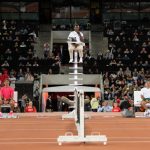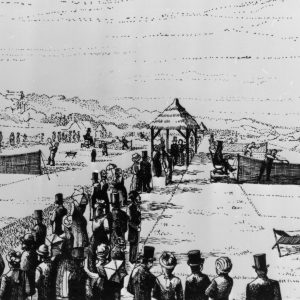New Books | A People’s History of Tennis
David Berry delves into the hidden history of the struggles around gender, race and class experienced by those wanting to play – and transform – the sport.
Author:
23 September 2020

This is a lightly edited excerpt from A People’s History of Tennis (Pluto Press, 2020) by David Berry.
Immigrants
In the middle of Crouch End in north London – hemmed in by suburban streets, million-pound houses and a school proudly describing itself as “truly comprehensive” – is an open expanse of woods and meadows that has provided exercise and enjoyment for local people since the 1920s. Every weekend the area’s residents can be spotted here tending organic vegetables on their allotments, walking their Labradors and Labradoodles, or indulging in a game of cricket or tennis in one of the half-dozen clubs that jostle for territory here in this space known as Crouch End Playing Fields.
As you enter the fields from the main entrance in Park Road, the first tennis club you come to is called Georgians. It is a relatively new club with an array of clay, carpet and artificial grass courts painted in red, blue and green. The club house is well equipped with a coffee machine, bar and satellite television and there are four coaches who offer a wide range of courses to club members including cardio tennis, a Monday evening ladies session and a performance programme for talented youngsters. Fifty years ago, long before Georgians existed, the tennis played on this spot was more basic. In the late 1960s, there were four red shale courts here, all of which had seen better days, a dilapidated club house with no heating or showers and just one coach. That coach, however, was Cas Fish.
Cas Fish was an autodidact with a goatee beard and confrontational manner who first played tennis in his native Caernarfon in North Wales in the early 1950s when he was 15. The game quickly became his passion and teaching tennis to youngsters his life’s work. For five decades, until his death at the turn of the 21st century, Fish gave tennis lessons which emphasised “character, grit and courage” rather than sound technique and correct strokes, the conventional coaching goals of that time. Never the most tactful of souls, Fish also found plenty of time to take on a self-appointed role as the Lawn Tennis Association’s “most outspoken critic”. He constantly lampooned the British tennis establishment and dismissed most tennis clubs as “social gatherings for middle-aged people”. “The wrong people are playing tennis in this country,” he maintained. “If we ever want to be good as a tennis nation we are going to have to find ways of getting the right people into the game.”
Related article:
In the autumn of 1967, Fish set out to do just that. On those four battered shale courts in Crouch End Playing Fields, he set up the Dolphin Squad which would meet on Saturday and Sunday afternoons throughout the year for fitness training and tennis drills. The squad would be open to any promising junior to join as long as they committed to 15 hours of practice a week and accepted that there would be “no more parties and late nights, no more boy and girl friends”. “You get up early in the morning and get in an hour or more practice before breakfast,” he told prospective squad members, “after school in the afternoon you head for the tennis court and play until you can’t see the ball any longer, then you go home and do your school work and somewhere along the way you fit in a meal.”
It was a taxing regime with little space for fun, although there were few complaints from participants or their parents. The experience of playing in the Dolphin Squad was summed up by a comment Fish once made when they played another club. “My boys and girls didn’t come here to enjoy themselves,” he said, “they come here to win.” And win they did, match after match after match. Soon Cas Fish was producing the champions he craved and his methods started attracting national attention. In the summer of 1969 one of the first invitations the British player Ann Jones accepted after winning the Wimbledon Ladies’ Singles title in July was from Fish to come and meet his squad.
Related article:
Word of Jones’ impending visit spread around north London and one youngster who turned up to watch was a 15 year old from Wood Green called Raph Harvey. “There were 20 boys and girls knocking up and doing drills with Ann,” Harvey remembered, “and I thought crikey these are brilliant. Everything I saw those boys and girls doing, I wanted to be like them.” In time he would, although there would always be one major difference. Raph and the three school chums that came with him that afternoon were black and the Dolphin Squad, like most tennis in Britain at the time, was white. It was one more thing Cas Fish was determined to change. He picked out Raph and the other three enthusiastic black teenagers from the crowd and encouraged them to join his squad. Perhaps here was an untapped source of tennis talent which would produce the world-beater he longed for. He certainly had no competition from the Lawn Tennis Association which at the time had little interest in encouraging play in the growing British black community even among those who were developing a passion for sport.
There had been black people playing games in Britain at the highest level since the professional footballer Arthur Wharton appeared for Rotherham in 1889. But their numbers, like the total number of permanent black residents here, remained small until the Caribbean immigration to Britain after World War II. Between June 1948 when the Empire Windrush arrived in Tilbury dock from Jamaica, and 1962 when the Commonwealth Immigration Act imposed restrictions on immigration, some half a million West Indians moved to the UK for work, many responding to advertisements from London Transport or the National Health Service which advertised vacancies all over the Caribbean. The children these immigrants brought with them and the children they would conceive when they settled here changed the colour of British sport. From second- and third-generation West Indians in Britain came much of the talent that now dominates British football, athletics and boxing. In 1969, Cas Fish saw no reason why tennis should not be the same. He was sure his methods could persuade young black men and women with sporting ability to opt for tennis rather than soccer or running. Perhaps in time he could produce a British Arthur Ashe, the black American who was then one of the top tennis players in the world.
Related article:
Neither Raph Harvey nor any of his friends seemed likely to be another Ashe. They were in their mid-teens when they joined the squad and too old to be moulded into champions. They could, though, be role models for their younger brothers, sisters, cousins and friends. Raph was certainly keen. In 1965, when he was 11, he had left the hamlet of Bath in West Jamaica to join his mother who was working as a nurse in a north London hospital. At school he played football but he was small and wiry and not good enough for the team so he tried tennis: “I used to borrow a tennis racket from the school sports room and the PE master encouraged me and I just turned out to be better than everyone else. A lot of people respected that.”
Tennis became his sport, and for several years in his teens he played every weekend and many weekday evenings with his friend Errol Francis, two years younger than him who had come to Britain from Jamaica a few years earlier when he was four. “Errol and I never had much money, so we used to play with balls that were bald and stick newspaper in our shoes to cover over the holes. We used to come down and play until it got so dark we were playing at night. Errol didn’t need to come as far as I did though because his school [that ‘truly comprehensive’ one] was just next to the club.”
None of the four black members of the Dolphin Squad ever became national champions, although some of the white boys did. “The members of the squad who improved a lot quicker than me,” Raph reflected, “were the white guys who could afford individual coaching and lessons as well as playing in the group sessions. I didn’t get any individual lessons which I would have liked but my mom couldn’t afford them.” One or two of the more talented white members of the squad now earn their living from tennis. Raph works as a bus driver.




